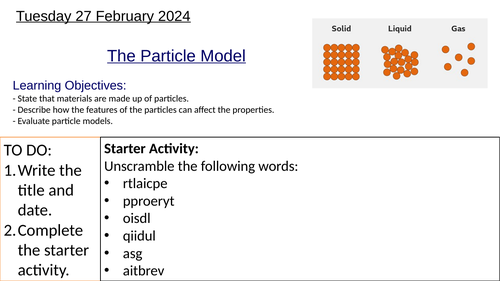
This PowerPoint resource introduces middle school students to the fundamental concept of matter being composed of particles. It emphasizes how particle behavior and arrangement influence the properties of solids, liquids, and gases. The lesson combines interactive activities and relatable examples to build a foundational understanding of particle theory.
Key learning objectives:
- Stating that all materials are made up of particles.
- Describing how particle arrangement, type, and movement determine the properties of matter.
- Evaluating models used to represent particles and identifying their advantages and limitations.
Resource features:
The lesson begins with a starter activity where students unscramble key terms related to the topic (e.g., particle, property, solid, liquid, gas, vibrate) and identify solids, liquids, and gases in their environment. Core concepts are introduced with detailed visuals and examples:
What are Particles?
Explains that matter consists of particles too small to see, with comparisons like a glass of water containing billions of particles.
Particle Behavior in States of Matter:
Solids: Particles are tightly packed and vibrate in place, explaining their fixed shape.
Liquids: Particles are close but can move past each other, allowing liquids to flow and take the shape of their container.
Gases: Particles are far apart and move rapidly in all directions, filling any space available.
Using Models to Represent Particles:
Lego bricks demonstrate particle arrangements, highlighting the strengths and limitations of this model, such as not accurately showing movement or relative sizes of gaps.
Interactive tasks include:
- Identifying properties of materials based on particle arrangements.
- Discussing the limitations of particle models and proposing improvements.
- Completing questions about density, movement, and compressibility, comparing substances like gold, aluminum, and oxygen.
The plenary consolidates learning by asking students to explain why materials behave differently based on particle theory.
File details:
This editable ‘.pptx’ file aligns with middle school science curricula and introduces key particle model concepts in an accessible way. It includes structured explanations, interactive activities, and practical examples, making it an essential resource for teaching the basics of the particle model.
Something went wrong, please try again later.
This resource hasn't been reviewed yet
To ensure quality for our reviews, only customers who have purchased this resource can review it
Report this resourceto let us know if it violates our terms and conditions.
Our customer service team will review your report and will be in touch.
